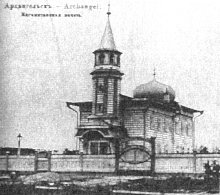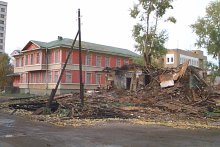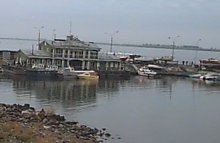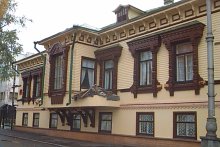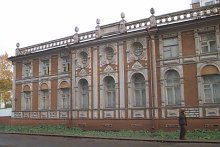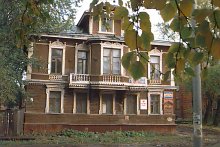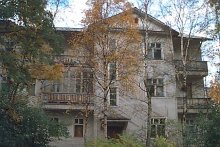Nostalgia for a Wooden City
is the name of a book by Yuri Barashkov, teacher at the Construction Department of the Arkhangelsk Timber-Technical Institute. I always admired the many wooden houses in the city of Arkhangelsk and Barashkov's book helped me to find some of the remaining buildings from Arkhangelsk's past.
Here is a short summary of Barashkov's book.
The urban architecture differs strongly from the rural architecture, which you can find at the open-air-museum Maliye Karelie for instance.
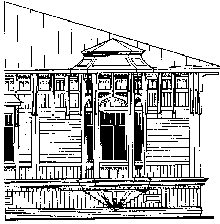
Detail from the Scharbin-House, at Ul. Loginova, 9 |
At the end of the 19th century, beginning of the 20th century, Arkhangelsk was a flourishing city, because of the timber-industry. More and more houses were built and the city became the world's largest ensemble of wooden architecture.
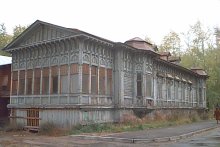
The Scharbin-House at Ul. Loginova, 9
Some of the houses still exist, but many are destroyed, due to the social and political events, others are gone because of neglect. |
Many buildings are still in use, like the green riverhouse or are undergoing reconstruction, like the beautiful living house at the bank of the Northern Dvina River, which now serves as an artschool for children.
Many wooden houses are reconstructed or relocated at the Prospekt Tsumbarova - Litsinskaja, which is also known as the museum-street. Not only for touristical reasons, these houses are in use.
Yuri Barashkov
Nostalgia pa deverjanamu gorody (sorry for bad transcription)
Printing House 'Krypto-Golos', Moscow 1992
ISBN 5-900229-01-7
3000 rubles
© Yuri Barashkov
Summary
Nostalgia for a wooden city
Yuri Barashkov's book "Nostalgia For a Wooden City" opens a window on the architecture, traditions and ways of life of the Russian city of Arkhangelsk in the late 19th and early 20th centuries. It was by that time that Arkhangelsk, lying amid forests on the shore of the northern White Sea, had become the world's largest and unique ensemble of handsome timber structures. Over centuries Russian northerners had devised a special type of home, well adapted to the harsh climate, a comfortable spacious "Arkhangelsk house", largely standard in design and construction, but endlessly variable and individual in detail and richly decorated in a national style. Later constructions of the period of flourishing of wooden architecture reveal characteristic signs of classicism, "Swiss Style", modernism and constructivism.
The reader watches an "Arkhangelsk house" being built, learns what the citizens did on weekdays and holidays, walks the city's streets, visits the market, the port, a sawmill, a church, and even a ... bath-house.
After World War II, mass construction of brick and concrete housing blocks threatened the wooden city with extinctions, but the efforts of enthusiasts, backed by a majority of citizens, gave timber monuments a new lease of live.
Old Arkhangelsk, the facades and interiors of its buildings, are brought to life by nearly 200 illustrations - reproductions of engravings, photographs and construction blueprints, collected by the author, a professional architect, over more than 40 years.
This Site's URL: http://www.avantart.com


